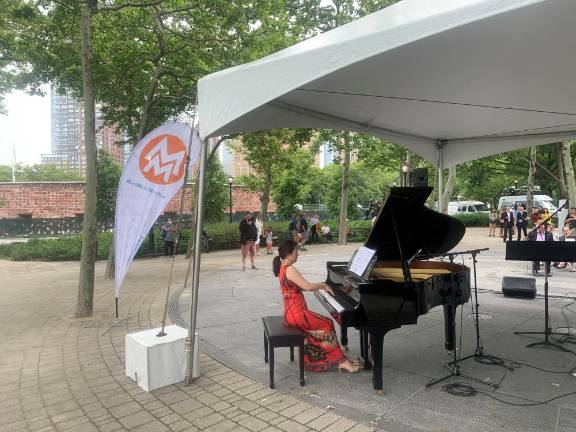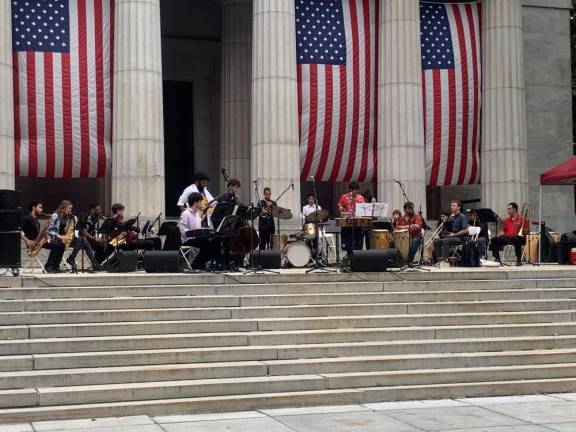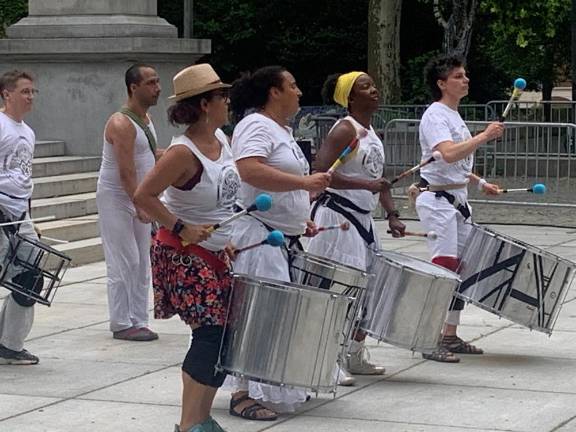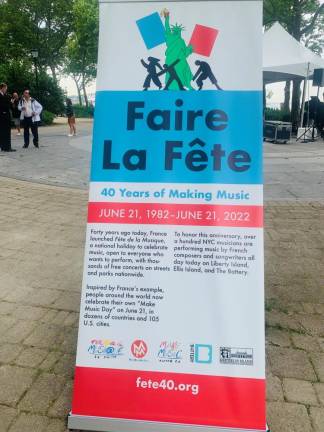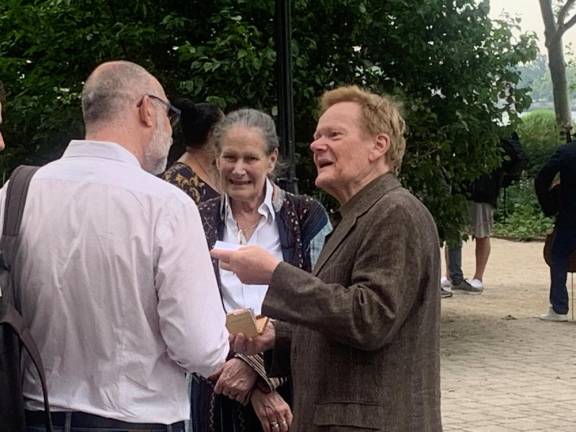June 21 dawned as an average day in Manhattan, but, by sunset, a lot of tired musicians and listeners had the rare experience of being almost overwhelmed.
That day has seen a vast proliferation of live music, with 140 venues citywide, and many in New York County alone, every event free.
Just about every variety of music that we know was available: from a capella to world, no musical style was left untouched for savvy Manhattanites. Make Music is a free celebration of music around the world every June 21. Its origins date to 1982 in France by then-Culture Minister Jack Lang, who created the Fête de la Musique.
Completely egalitarian, Make Music is open to anyone who wants to take part. Every musician, young, old, amateur, and professional, enlivens streets, parks, plazas and porches to share their music with friends, neighbors, and strangers. All of it is free worldwide and open to the public. As a decision made at the first event in 1982, the event would take always place on the summer solstice, June 21.
The Battery Park kickoff event was held on solstice Tuesday, in view of the Statue of Liberty, a gift from France to the United States.
Aaron Friedman, executive director of the Make Music Alliance, which oversees the Make Music events all over the United States, related to the audience how it jumped to America. “I was in France in 2006,” he said, “and attended a Festival Event in France.” Then and there, he made the decision to bring this concept to our shores, the first events held here the next year.
French Ambassador to the United States Phillipe Etienne noted that in the last 40 years, support has always come from the communities, and had inspired 120 countries worldwide and 1,000 cities, all in the spirit of peace, friendship and harmony. He went on thank the multiple networks of volunteers and musicians that have made the events possible.
Executive Director James Burke, also a musician, expounded on how this 16th annual event had over 5,000 New York City musicians, from newbies to professionals, and performances would be in city parks, community gardens, mom and pop stores, dozens of plazas on open streets, and also in less advantaged areas, where events like this are less common. Music all around our city.
Statue of Liberty Dedication
After the speeches, Camille Saint-Saens’ “Carnival of the Animals” was performed by a septet, including three French musicians currently residing in New York City. The first performance of it was in 1886, when the Statue of Liberty was dedicated in New York Harbor. The audience was in sight of Betholdi’s work against the backdrop of waterborne craft heading in all directions. Each movement of the piece, 15 in all, was bridged by short poetic notations, read by the invited guests including the Ambassador and noted tightrope walker Phillipe Petit.
Different Musical Styles
This reporter attended two separate afternoon events, with completely different musical styles, one more ethnic, one more classical, both in the Columbia University area.
The General Grant National Memorial would not be the first place that pops into one’s mind as a place to hear music, but after seeing the Mambembé Samba Reggae, led by Brazilian master percussionist Everton Isidoro, and hearing the momentous cheering, any potential doubt for that location disappeared. Mambembé combines drums and samba reggae, to value, preserve and expand Afro-Brazilian percussive music, performed by multicultural musicians.
And they were LOUD! Against the backdrop of Riverside Park’s trees and the Hudson River so close, it didn’t matter at all. The infectious rhythm and the broad smiling faces of the musicians were exactly what Etienne talked about when he spoke of peace and harmony. Their craft, laid out for all to see, was a positive convergence.
This was part of Pueblo Harlem, the Afro Latin Jazz Alliance’s (ALJA) annual celebration of Hispanic heritage and culture, as part of Make Music New York.
The Fat Cats
But Mambembé were not the only performers. The Fat Afro Latin Jazz Cats All-Star Band was a collection of pre-professional youth ensembles of the non-profit Afro Latin Jazz Alliance. While the regular Jazz Cats, high school students who weren’t able to participate because of the last days of the school year, some Fat Cat alums, now college students, jumped in to fill the breach.
The Fat Cats were started in 2010 by ALJA’s Artistic Director Arturo O’Farrill, in the Greenwich Village basement billiards and jazz club, the Fat Cats. The ensembles are made up of some of the city’s finest young musicians hailing from all over the five boroughs, forming two small ensembles and a big band, everyone from a disparate background. And they played some incredibly great music together, Afro-Latin music with a youthful exuberance. One older gentleman in the audience just kept dancing for both sets of musicians, and everyone in the audience was smiling.
The day ended for for most activities by 7 p.m.; my last venue was a 6 p.m. performance by the Art Song Preservation Society of New York, a nonprofit arts organization dedicated to the art song repertoire and recital. Art songs are music compositions for voice and instrumental accompaniment, using poetic text with the music. This musical food for the soul was a recital by 14 vocalists who performed in an almost two-hour long recital at the Manhattan School of Music. The intimate 70-seat recital space provided a perfect venue for this unique form of music. One such piece, “Song of the Yue,” sung by Soprano Claire Suhui Dai, was from ancient China. Again, another unusual facet of music, made available through Make Music Day.
You will want to mark June 21, 2023 in your calendars to make sure that you do not miss out on an incredible array of musical entertainment available all day to everyone. No matter what your preferences, push the envelope a little and learn and enjoy other music forms you may not be aware of.
